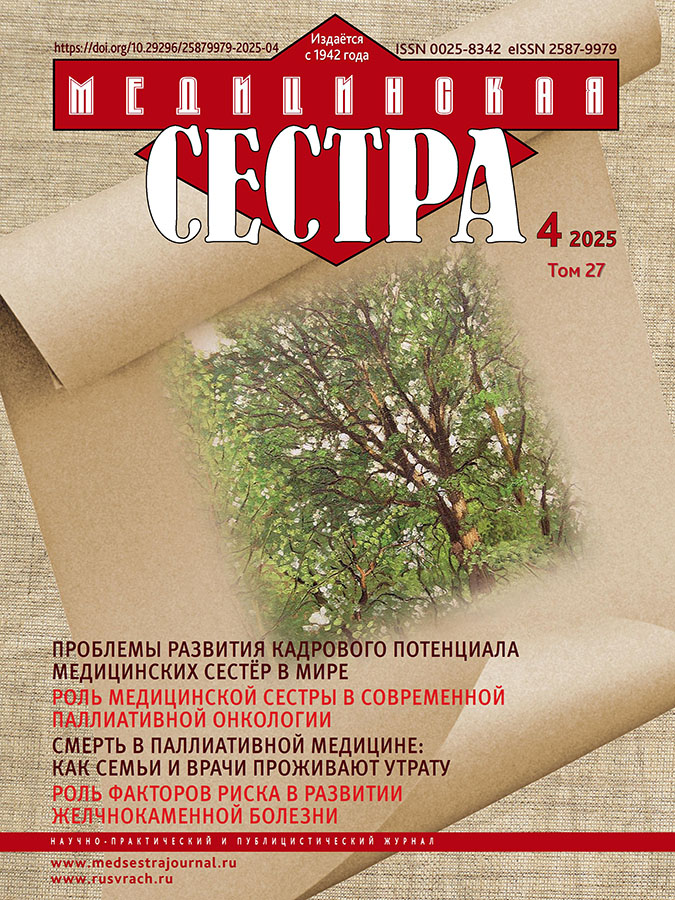Review of hygienic measures for oral care of patients in intensive care units
- 作者: Krylova T.N.1, Ostrovskaya I.V.2, Mirilashvili D.T.3
-
隶属关系:
- Federal Research and Clinical Center of Intensive Care Medicine and Rehabilitology
- Branch of the S.M. Kirov Military Medical Academy of the Ministry of Defense of the Russian Federation in Moscow
- Federal State Budgetary Educational Institution of Higher Education "Russian University of Medicine"
- 期: 卷 27, 编号 4 (2025)
- 页面: 11-15
- 栏目: Topical theme
- URL: https://journals.eco-vector.com/0025-8342/article/view/685070
- DOI: https://doi.org/10.29296/25879979-2025-04-03
- ID: 685070
如何引用文章
详细
The relevance of the study of the problem of organization and implementation of hygienic measures for oral care of patients in intensive care units is associated with the fact that inadequate oral care is one of the conditions for the development of nosocomial infections, in particular, ventilator-associated pneumonia.
Inadequate care can be caused by various reasons, including the lack of clear instructions on the timing and intensity of tooth and tongue brushing, and the use of outdated methods and materials.
We believe that the technology of “Oral Care of the Patient in the ICU” needs to be reviewed in order to bring it up to date.
关键词
全文:
作者简介
Tatiana Krylova
Federal Research and Clinical Center of Intensive Care Medicine and Rehabilitology
编辑信件的主要联系方式.
Email: tkrylova@fnkcrr.ru
ORCID iD: 0009-0000-1259-1563
SPIN 代码: 9055-4576
Bachelor of Nursing, Master of Healthcare Management, Junior Researcher, Federal Research and Clinical Center of Intensive Care Medicine and Rehabilitology, anesthesia nurse
俄罗斯联邦, MoscowIrina Ostrovskaya
Branch of the S.M. Kirov Military Medical Academy of the Ministry of Defense of the Russian Federation in Moscow
Email: tkrylova@fnkcrr.ru
ORCID iD: 0000-0001-7932-4216
SPIN 代码: 2400-9600
Ph.D., МВА; associate professor, Nursing Management Department
俄罗斯联邦, MoscowDiana Mirilashvili
Federal State Budgetary Educational Institution of Higher Education "Russian University of Medicine"
Email: tkrylova@fnkcrr.ru
ORCID iD: 0009-0005-1173-838X
Student of the Faculty of Dentistry
俄罗斯联邦, Moscow参考
- National concept of prevention of healthcare-associated infections. URL: https://docs.cntd.ru/document/ 499002572 (accessed: 12.01.2025).
- World Alliance for Patient Safety: forward program. WHO. 2004. URL: https://iris.who.int/bitstream/handle/10665/43072/924 1592443.pdf (accessed: 12.01.2025).
- Timoshevsky A.A. Infectious safety in a medical organization. Health care-associated infections (HAIs): Educational and methodical manual for students of medical education. Moscow : NIIOZMM DZM, 2023: 50 p. URL: https://niioz.ru/moskovskaya-meditsina/izdaniya-nii/metodicheskie-posobiya (accessed: 12.12.2024).
- Fundamentals of the modern classification of infections associated with the provision of medical care. / V.I. Pokrovsky [et al.] Epidemiology and Infectious Diseases. 2022; 3: 4–10. URL: https://epidemiology-journal.ru/ru/archive/article/11392 (accessed: 15.12.2024).
- Hunter J.D. Ventilator associated pneumonia. BMJ. 2012; 344: e3325. doi: 10.1136/bmj.e3325 (accessed 20.12.2024).
- Bonten M. Ventilator-Associated Pneumonia: Preventing the Inevitable. Clinical Infectious Diseases. 2011; 52 (1): 115–121, https://doi.org/10.1093/cid/ciq075 (accessed 20.11.2024).
- Klompas M. The paradox of ventilator-associated pneumonia prevention measures. Crit Care. 2009; 13 (5): 315. doi: 10.1186/cc8036. Epub 2009 Oct 15. (accessed 20.11.2024).
- Xie X., Lyu J., Hussain T., Li M. Drug Prevention and Control of Ventilator-Associated Pneumonia. Front Pharmacol. 2019; 10: 298. doi: 10.3389/fphar.2019.00298. (accessed 20.11.2024).
- Ling M.L., Apisarnthanarak A., Madriaga G. The Burden of Healthcare-Associated Infections in Southeast Asia: A Systematic Literature Review and Meta-analysis. Clin Infect Dis. 2015; 60 (11): 1690–9. doi: 10.1093/cid/civ095. (accessed 20.11.2024).
- Egorova I.N. et al. Ventilator-associated pneumonia: diagnosis, prevention, treatment (current status of the issue). Obshchaya resuscitologiya. 2010; 1: 79–88. URL: https://www.reanimatology.com/rmt/article/view/511/301 (accessed: 20.11.2024).
- Yakovlev S.V. et al. Multicentre study of the prevalence and clinical value of hospital-acquired infections in emergency hospitals of Russia: ERGINI study team. Antibiotiki i himioterapija. 2016; 61 (5–6): 32–42. URL: https://cyberleninka.ru/article/n/rasprostranyonnost-i-klinicheskoe-znachenie-nozokomialnyh-infektsiy-v-lechebnyh-uchrezhdeniyah-rossii-issledovanie-ergini (accessed: 20.11.2024).
- Bagin V.A., Rudnov V.A., Astafieva M.N. Application of chlorhexidine for the prevention of hospital infections in intensive care units: current state of the problem. Clinical microbiology and antimicrobial chemotherapy. 2020, 1: 30–38. URL: https://cyberleninka.ru/article/n/primenenie-hlorgeksidina-dlya-profilaktiki-gospitalnyh-infektsiy-v-otdeleniyah-reanimatsii-i-intensivnoy-terapii-sovremennoe (accessed: 13.01.2025).
- Cooper A.S. Oral Hygiene Care to Prevent Ventilator-Associated Pneumonia in Critically Ill Patients. Crit Care Nurse. 2021; 41 (4): 80–82. doi: 10.4037/ccn2021314. (accessed 20.01.2025).
- Rudnov V.A., Ershova O.N., Mishnev O.D. Pathogenesis of nosocomial pneumonia. // Nosocomial pneumonia in adults: Russian national recommendations. / Edited by B.R. Gelfand. Moscow: Medical Information Agency, 2016: 36–41. URL: https://webmed.irkutsk.ru/doc/pdf/nozopneumonia.pdf (accessed: 15.01.2025).
- Ignatenko O.V. et al. Prophylaxis of nosocomial pneumonia. // Nosocomial pneumonia in adults: Russian national recommendation. / Ed. by B.R. Gelfand. Moscow: Medical Information Agency, 2016: 152–158. URL: https://webmed.irkutsk.ru/doc/pdf/nozopneumonia.pdf (accessed: 17.01.2025).
- Katola V.M., Tarasenko S.V., Komogortseva V.E. Influence of oral microbiota on the development of inflammation and somatic diseases. Russian stomatologic journal. 2018; 22 (3): 162–165. URL: https://cyberleninka.ru/article/n/vliyanie-mikrobioty-polosti-rta-na-razvitie-vospaleniya-i-somaticheskih-zabolevaniy (accessed: 17.01.2025).
- Plantinga N.L., Wittekamp B.H.J., Leleu K. et al. Oral mucosal adverse events with chlorhexidine 2% mouthwash in ICU. Intens Care Med. 2016; 42 (4): 620–621. doi: 10.1007/s00134-016-4217-7 (accessed 17.01.2025).
- Klompas M. Oropharyngeal Decontamination with Antiseptics to Prevent Ventilator-associated pneumonia: rethinking the benefits of chlorhexidine. Semin Respir Crit Care Med. 2017; 38 (03): 381390. doi: 10.1055/s-0037-1602584 (accessed on 25.01.2025).
- Musina L.T., Egorova A.B., Urazova R.Z. Influence of antiseptics on the state of oral cavity microflora. Kazan Medical Journal, 2010. 91 (4): 525–529. URL: https://cyberleninka.ru/article/n/vliyanie-antiseptikov-na-sostoyanie-mikroflory-polosti-rta (accessed: 17.01.2025)
- Valieva R.M., Negametzyanov N.G., Ismailov R.M., Ismailov K.R. On the role of oral hygiene. Bulletin of the Kazakh NMU. 2017; 1: 230–231. URL: https://cyberleninka.ru/article/n/o-roli-gigieny-polosti-rta (date of reference: 13.01.2025).
- Maev I.V. et al. Features of damage to filiform papillae and biofilm microflora of the tongue mucosa in patients with gastroesophageal reflux disease. Archives of Pathology. 2019; 81 (1): 18–23. doi: 10.17116/patol20198101118 (accessed 03.01.2025).
补充文件





